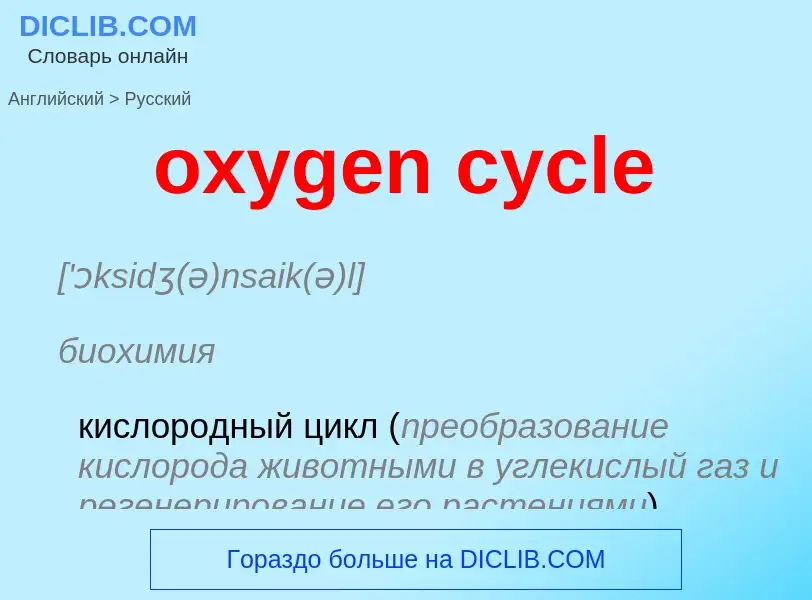Vertaling en analyse van woorden door kunstmatige intelligentie ChatGPT
Op deze pagina kunt u een gedetailleerde analyse krijgen van een woord of zin, geproduceerd met behulp van de beste kunstmatige intelligentietechnologie tot nu toe:
- hoe het woord wordt gebruikt
- gebruiksfrequentie
- het wordt vaker gebruikt in mondelinge of schriftelijke toespraken
- opties voor woordvertaling
- Gebruiksvoorbeelden (meerdere zinnen met vertaling)
- etymologie
oxygen cycle - vertaling naar russisch
['ɔksidʒ(ə)nsaik(ə)l]
биохимия
кислородный цикл (преобразование кислорода животными в углекислый газ и регенерирование его растениями)
общая лексика
газообразный кислород
медицина
оксигенотерапия
Definitie
Wikipedia

Oxygen cycle refers to the movement of oxygen through the atmosphere (air), biosphere (plants and animals) and the lithosphere (the Earth’s crust). The oxygen cycle demonstrates how free oxygen is made available in each of these regions, as well as how it is used. The oxygen cycle is the biogeochemical cycle of oxygen atoms between different oxidation states in ions, oxides, and molecules through redox reactions within and between the spheres/reservoirs of the planet Earth. The word oxygen in the literature typically refers to the most common oxygen allotrope, elemental/diatomic oxygen (O2), as it is a common product or reactant of many biogeochemical redox reactions within the cycle. Processes within the oxygen cycle are considered to be biological or geological and are evaluated as either a source (O2 production) or sink (O2 consumption).
Oxygen is one of the most common elements on Earth and represents a large portion of each main reservoir. By far the largest reservoir of Earth's oxygen is within the silicate and oxide minerals of the crust and mantle (99.5% by weight). The Earth's atmosphere, hydrosphere, and biosphere together hold less than 0.05% of the Earth's total mass of oxygen. Besides O2, additional oxygen atoms are present in various forms spread throughout the surface reservoirs in the molecules of biomass, H2O, CO2, HNO3, NO, NO2, CO, H2O2, O3, SO2, H2SO4, MgO, CaO, AlO, SiO2, and PO4.








![Oxygen and [[MAPP gas]] compressed-gas cylinders with regulators Oxygen and [[MAPP gas]] compressed-gas cylinders with regulators](https://commons.wikimedia.org/wiki/Special:FilePath/Compressed gas cylinders.mapp and oxygen.triddle.jpg?width=200)




![[[Space-filling model]] representation of dioxygen (O<sub>2</sub>) molecule [[Space-filling model]] representation of dioxygen (O<sub>2</sub>) molecule](https://commons.wikimedia.org/wiki/Special:FilePath/Oxygen molecule.png?width=200)



![2}} is used in [[space suit]]s. 2}} is used in [[space suit]]s.](https://commons.wikimedia.org/wiki/Special:FilePath/STS057-89-067 - Wisoff on the Arm (Retouched).jpg?width=200)





![Oxygen piping and regulator with flow meter, for oxygen therapy, mounted in an [[ambulance]] Oxygen piping and regulator with flow meter, for oxygen therapy, mounted in an [[ambulance]]](https://commons.wikimedia.org/wiki/Special:FilePath/Oxygen piping.png?width=200)
